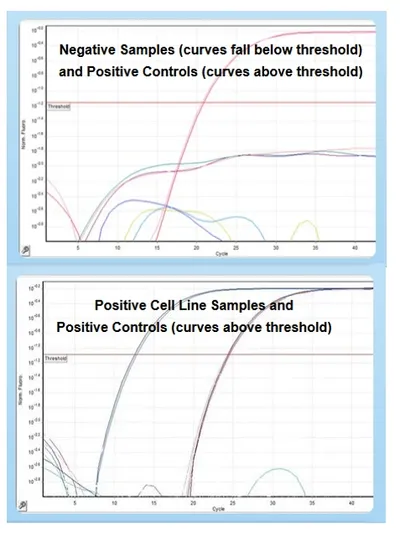Real-time qPCR Mycoplasma Contamination Detection Service
Labcorp's cell line testing division offers a reliable, quick and economically priced real-time qPCR test for routine detection of contaminating Mycoplasma species in your continuous cell lines. Appropriate positive and negative controls are included in every assay to ensure the validity of the test results.
Rapid Mycoplasma Detection via Real-time qPCR
Venor® GeM qEP (Minerva Biolabs): Detection of at least 107 Mycoplasma species including the most common cell culture contaminants: Mycoplasma orale, M. hyorhinis, M. arginini, M. fermentans, M. salivarium, M. hominis M. pneumoniae, Acholeplasma laidlawii, M. synoviae and M. Urea; detection of the highly conserved Mycoplasma 16S rRNA sequences present in genomic DNA samples with gene specific primers
- Highly sensitive: Limit of detection determined to be equivalent to (1-2) Mycoplasma genomes
- Rapid results: Results typically within 3-5 business days
- Easy sample submission: send one sample for both mycoplasma and cell line authentication (STR profiling) either as a cell pellet or genomic DNA
- Internal control included to identify false negative results
- Cross Reactivity: None with other bacterial and mammalian DNA
- Recommended for: Continuous cell cultures
- Cell line species accepted: All species
Price: $48/sample (DNA extraction charge will apply if sending cell pellets for myco only testing)
NOTE: Mycoplasma detection services are FOR RESEARCH ONLY; not for clinical diagnostic purposes.

Mycoplasma Information
-
What are Mycoplasmas?
Mycoplasmas have become one of the most widespread and severe contaminants within cell culture systems in research institutions. Mycoplasma is considered the smallest free-living organism capable of self-replication. They can be as small as 0.2-0.3µm in diameter, lack a cell wall, and are known to freely pass through some filters used to remove bacteria from cell culture.
-
How can I tell if my culture is contaminated with Mycoplasma?
Mycoplasma can attain high densities in cell cultures (i.e. 107 - 108mycoplasma/ml) without ANY noticeable changes to the pH of the medium and without causing increased turbidity. Typically there is an absence of visible morphological changes. Mycoplasma contamination cannot be detected using bright-field or phase microscopy, even at high magnification. In other words, you do not know mycoplasma is contaminating the cell culture without testing.
-
How common is Mycoplasma contamination in cell culture systems?
Estimates vary but research studies performed by different groups have shown anywhere from 5-35% of all cell cultures are contaminated with mycoplasma; the real percentage may be even higher because many researchers don't know that their cultures are contaminated. If other types of bacterial contamination are a common occurrence in your lab, you most likely have mycoplasma contamination as well and just may not know it.
-
Why is Mycoplasma contamination bad for cell culture?
Due to the typically high concentrations of mycoplasma in infected cultures, mycoplasma often out-compete the host cells for essential nutrients resulting in altered growth and protein production.
-
Mycoplasma contamination has been shown to alter almost every cell culture property and characteristic measured
Mycoplasma contamination has been shown to alter almost every cell culture property and characteristic measured including:
- Altered DNA, RNA, and protein synthesis
- Lowered ATP levels
- Altered enzyme expression and activity
- Variable growth rates and viability
- Nucleic acid synthesis which leads to aneuploidy and other chromosomal irregularities
- Cytotoxicity
- Decreased transfection efficiency and
- Culture starvation.
As with using a misidentified cell line, using cell cultures contaminated with mycoplasma calls into question the validity of the experiments using that cell line.
-
I use antibiotics in my medium, shouldn't that take care of the Mycoplasma contamination?
No! Actually, mycoplasma contamination rates are much higher than average for cell lines that are routinely grown in medium containing antibiotics (72% were contaminated) versus no antibiotics in the medium (7% contaminated) (Barile, et al 1973). This is due to the mycoplasma developing partial or complete antibiotic-resistance to antibiotics such as penicillin and streptomycin. In medium containing antibiotics, other microbial contaminants disappear allowing plenty of room for antibiotic resistant mycoplasma to grow and spread through the culture undetected.
-
How often should I be testing for Mycoplasma?
Just like human cell line authentication or mouse cell line authentication, testing for mycoplasma should occur at a regular basis while the cell culture is actively growing. It is recommended that you test for mycoplasma contamination, as applicable:
- When creating a master cell bank OR working cell bank
- Before beginning a new series of experiments
- When the cell line is not behaving as expected
- Every 2 months that the cell culture is actively growing
- Before publication of experimental data
- These steps are crucial to the success and repeatability of the research and to the acceptance of the research in the scientific community.
References
- Armstrong, S.E., Mariano, J.A., and D.J. Lundin. "The scope of myocplasma contamination within the biopharmaceutical industry", Biologicals 38 (2010) 211-213.
- Barile, M.F., et al. "The identification and sources of mycoplasmas isolated from contaminated cell cultures". Ann. N.Y. Acad. Sci. 225 (1973) 251-264.
- Young, L., Sung, J., Stacey, G, and John R. Masters. "Detection of Mycoplasma in cell cultures", Nature Protocols, Vol. 5, No.5, (2010) 929-934.
Venor® GeM qEP kit - Product Insert
Sample Preparation for Mycoplasma Contamination Detection Assay
- We recommend that you passage the cell line for 3-6 days (or 1-2 passages) without antibiotics to get the best result (antibiotics can suppress a mycoplasma contamination but not eliminate it).
- You can submit the SAME sample types as for the cell line authentication testing.
- We can use ONE sample for both STR profiling (cell line authentication) AND qPCR mycoplasma testing; same minimum volume/cell requirements as for cell line authentication testing.



